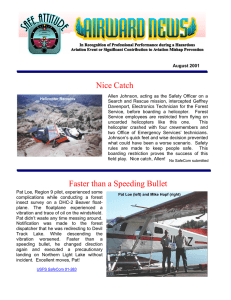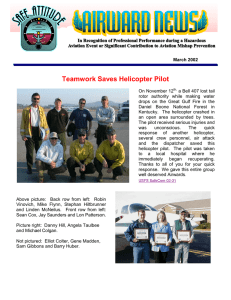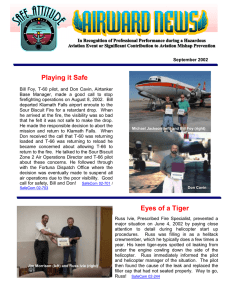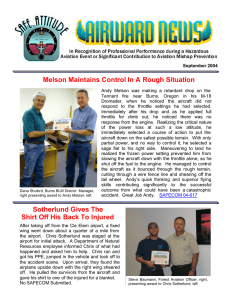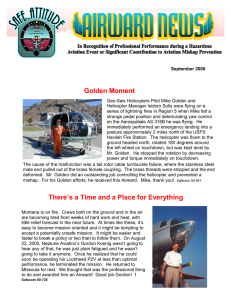June 2009 SAFECOM Summary SAFECOMS by Aircraft Type
advertisement
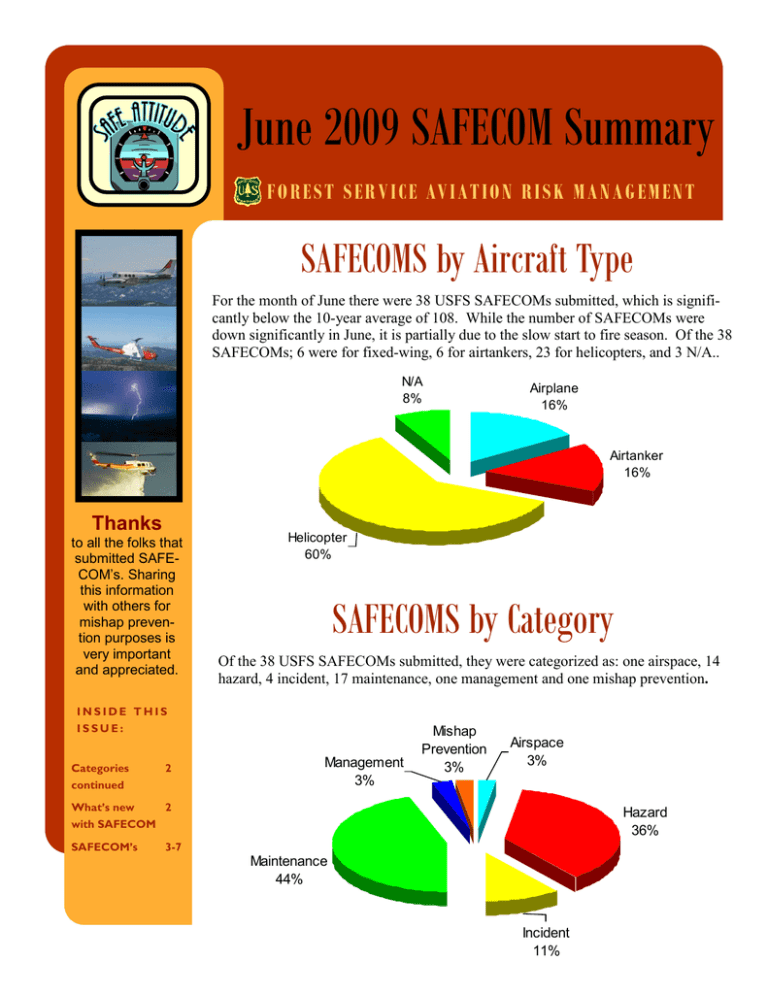
June 2009 SAFECOM Summary
F O R E S T S E R V I C E AV I AT I O N R I S K M A N A G E M E N T
SAFECOMS by Aircraft Type
For the month of June there were 38 USFS SAFECOMs submitted, which is significantly below the 10-year average of 108. While the number of SAFECOMs were
down significantly in June, it is partially due to the slow start to fire season. Of the 38
SAFECOMs; 6 were for fixed-wing, 6 for airtankers, 23 for helicopters, and 3 N/A..
N/A
8%
Airplane
16%
Airtanker
16%
Thanks
to all the folks that
submitted SAFECOM’s. Sharing
this information
with others for
mishap prevention purposes is
very important
and appreciated.
Helicopter
60%
SAFECOMS by Category
Of the 38 USFS SAFECOMs submitted, they were categorized as: one airspace, 14
hazard, 4 incident, 17 maintenance, one management and one mishap prevention.
INSIDE THIS
ISSUE:
Categories
continued
2
Management
3%
Mishap
Prevention
3%
Airspace
3%
What’s new
2
with SAFECOM
SAFECOM’s
Hazard
36%
3-7
Maintenance
44%
Incident
11%
PAGE
SAFECOM’s by Category continued
2
AIRSPACE There was only one airspace SAFECOM 09-0344. Firefighters did an outstanding job of notifying the helicopters working a prescribed fire of another helicopter passing over them.
INCIDENT Four incidents were reported; dropped load in tuna net, broken rod attaching seat in place, rappeller hard landing and a bird strike
in an air attack platform.
MAINTENANCE There were 17 SAFECOM’s reported on maintenance
issues. There was one engine shutdown reported on a P2V. The most
reported were Chip lights and caution lights.
MANAGEMENT There was one SAFECOM categorized in this category regarding AFF in CWN/BPA contracts.
Dr. James Reason,
among other current
MISHAP PREVENTION One SAFECOM was categorized as Kudos
organizational system
among other things for a crew that has been diligent in their equipment
safety theorists,
inspections and reported many deficiencies.
stresses the need for a
“reporting culture” as
an important aspect of
safety culture. The
organization must
do what it can to
HAT S NEW WITH
cultivate the
willingness of its
First of all, the system was recently moved to a new server and we are still working out
members to
some of the security bugs. If you have any problems submitting a SAFECOM, like a
contribute to the
message accusing you of being a “hacker” please contact Barb Hall immediately at
organization’s
208-387-5285. Thanks for your notifications and patience as we worked through
knowledge base.
some of these issues.
Dr. Reason further
stresses the need
The SAFECOM Working Group (SWG) was established over a year ago to identify
for a “just culture,” and brainstorm some of the issues surrounding the SAFECOM system. We’ve had
where employees
some great ideas submitted and appreciate every one of them, keep ‘em coming…
have the
The group meets monthly via conference call to work on continuing and new projects.
confidence that,
Some of the things the group has accomplished to date are: A SAFETY Alert on effecwhile they will be
tive use of the SAFECOM System, SAFECOM training, revised SAFECOM Manager
instructions, promoting the SAFECOM system, and adding SAFETY ALERTS pertainheld accountable
ing to the SAFECOM system on the web page as well as a contact list. A couple of
for their actions,
things we are currently working on are a SAFECOM survey and the ability to upload
the organization
picture files with a SAFECOM. If you have any comments or ideas please send them
will treat them
to Barb Hall bhall@fs.fed.us, Jami Anzalone jamianzalone@fs.fed.us or Lori Clark
fairly.
W
’
lclark@fs.fed.us.
JUNE
2009
SAFECOM
FOREST
SERVICE
AVIATION
RISK
MANAGEMENT
SAFECOM’s
PAGE
3
09-0360 - On 6/30/09, a relief pilot reported for duty on a prepositioned air tactical assignment. The ATGS
inspected the pilot's qualification card and found it to be in order. At around noon, air attack was requested to
fly a recon flight on an adjacent forest. After completing the mission and landing, the ATGS asked the pilot
about his background and what types of aircraft he had flown. At this time it was discovered that the pilot did
not meet the required pilot flight hours for Make and Model of the aircraft. The ATGS notified the Regional
Pilot Inspector and told him of his concerns regarding the pilot. The Regional Pilot Inspector instructed the
ATGS to not fly with the pilot again and stand down the aircraft. The pilot was released from duty and the aircraft was made unavailable until the vendor provided a qualified pilot. CORRECTIVE ACTION: RASM
comments: The vendor and the Regional Pilot Inspector discussed the intent and definition of Make and Model
as it relates to pilot carding. The vendor replaced the pilot with one that met Make and Model requirements.
Safety and pilot performance were not ever in question, but our minimum flight requirements set forth the
standard of our program and must be adhered to. It was a great catch on the part of the Air Attack. The lessons
here are to be sure to check approval cards, and if you have questions utilize the Regional Aviation Staff.
09-0355 - Taking off in a type II helicopter en route to an incident, a piece of asphalt from the helipad had
melted to the left skid of the helicopter. The helicopter had trouble taking off initially but eventually broke free
from the helipad, taking with it a large piece of asphalt. The parking tender tried to have the helicopter hold
hover but was unsuccessful and the helicopter took off with the piece of asphalt attached to the skid. The parking tender tried contacting the helicopter by radio but was unsuccessful due to fire traffic. CORRECTIVE
ACTION: Submitters Comments: Upon return to the heliport the asphalt was still attached to the helicopter.
The mechanic removed the asphalt and inspected for damage. No damage was found and the helicopter was
moved to a different part of the helipad. Currently the helipad asphalt, including a sinkhole remains in disrepair. The forest aviation officer and fire management have been notified. R5 RASM Comments: At the Base
readiness inspection a few weeks ago, the helipad was identified as needing attention in that is in poor condition. In this incident the material used for crack sealing is actually what was soft and stuck to the skid, along
with a piece of concrete from the pad. Contact with the Forest Aviation Officer has been made and they are
working with the road Maint. crew near the site to get the pad to a satisfactory condition. MAKE SURE YOU
HAVE POSITIVE COMMUNICATIONS BETWEEN THE AIRCRAFT AND HELIBASE.
09-0340 - On the 14th cargo load over a 2-day period, a tuna net broke open on a cargo letdown procedure.
The net contained 3, 5 gallon water cubees’ and had been used for all the previous loads of cargo. Upon inspection before takeoff for the cargo deployment, the spotter noticed wear on the net but no breaks. When the
ship lifted the spotter noticed that 2 of the cubees’ were stacked on top of one another. When the spotter released the double wrapped cargo, the load came to an almost immediate stop with no braking force provided
by the spotter. After about 2 seconds, the first cubee fell out of the net followed by a second, three seconds
later. Having a double wrap and only 45 pounds in the net, the spotter quickly lowered the helicopter and set
the cargo on the ground. Upon inspection a roughly 2 foot hole was found toward the center of the net. Although the strands of the net showed abrasions, none of the diameter seemed to be eaten into. Also of note was
the fact that one week earlier we had stripped the helipad down to repaint it leaving it essentially a rough piece
of concrete sandpaper. CORRECTIVE ACTION: 1. If your pad is a rough pored surface and you strip it down
to paint it, do not drag wear sensitive items across it multiple times. 2. It was my first cargo spot of the year
and i probably should have single wrapped it {might have reduce the high psi shockload from high density
items such as 2 cubees stacked on top of one another. 3. Do not use the net if it has any abrasion showing at
all. FAO COMMENTS: examined the net and pad, conferred with foreman and assistant. Discussed options
for smoothing the surface of pad. All nets were checked for similar signs of wear. Light-weight/light-duty
nets fairly susceptible to significant damage from abrasion. Awareness was raised.
JUNE
2009
SAFECOM
FOREST
SERVICE
AVIATION
RISK
MANAGEMENT
SAFECOM’s continued…...
PAGE
4
09-0339 - The helicopter and crew were released from the Forest and traveling back to home unit on June 21.
On takeoff from the airport, the helicopter manager contacted the dispatch on the local forest frequency to establish flight following. Although communications were good on the local frequency, we were planning to
travel through multiple dispatch zones, so the decision was made to switch over to National Flight Following
at that time. The helicopter made several attempts to contact the dispatch on National Flight Following, but
was unsuccessful. We could not hear dispatch calling back. We decided to continue flight following on the local frequency and try again in a few minutes. The next attempt was also unsuccessful. Dispatch then asked if
the helicopter had the tone 110.9 in both transmit and receive. We replied that we did not. At that time, we had
the tone only in transmit, and we were fairly confident that this was the national standard. Once we put it in
receive as well, we were then able to hear, and communicate with, the dispatch. However, in order to transition
over to the other zones to the home base utilizing National Flight Follow, we had to use the National Flight
Following frequency without the tone in the receive. CORRECTIVE ACTION: The dispatch corrected the
initial problem by asking the helicopter to tone receive. We programmed the helicopter radio so that we had
two NFF channels, one with {FM1} and one without {FM2} the receive tone of 110.9 so that we could talk to
two zones at the same time on the way to the home base. After landing at the home base, the manager called
the dispatch to make them aware of the issue. RASM: There is a lot of confusion with NFF. At this time National Flight Follow should only be toned on the transmit side (110.9). Some dispatches nationally have a
tone on the receive side which will not allow aircraft to communicate unless they tone the aircraft as well.
Communications and Forest Service leadership are trying to figure out how to resolve this issue. Each person
needs be understand that you maybe entering a unit that has toned the receive side of NFF. Confirm with the
local dispatch before departing to the unit.
09-0323 - This SAFECOM is in regards to a rope we received this year from the rappel rope vendor. The
manufacture date is 06-09 and was brand new when received. Before running the rope, the crew did a visual
inspection on the rope. The rope was then pulled at each end to remove twists. Subsequently the rope was then
run 10 times on each end then engraved. Before we rappelled the rope at the standard 250 feet in flat and open
terrain, we had the rope inspected again and found quite a few anomalies, ranging from multiple puffs, cut
strands, bundles that are tied together, and strands of a bundle that are running perpendicular to the bundle itself. Upon further inspection by a spotter, the rope was put out of service. CORRECTIVE ACTION: After
alerting Region 2 Helicopter Operations Specialist and conferring with Missoula Technology and Development Center, the rope was photographed and documented. The rappel rope vendor is in the process of sending
the rappel crew a new rope. The rope is being sent back to the vendor for inspection and further troubleshooting. I would like to recognize the crewmembers for their diligence while inspecting their rappel equipment.
This was a great find and could have been easily overseen. RASM: I too would like to recognize the rappel
crew for their vigilance during the inspection process. This is the second profound equipment issue this crew
has found this year. One of the inspections has manifested in Safety Alert No. IA 09-03. It is evident that the
program is stressing the importance of good equipment inspections.
09-0286 - On 6/7/2009 while taking off for their 2nd load to the baseline fire, tanker xx reported that they had
an issue with their #2 jet. They never left the ground, and when they taxied back to the tanker base ramp discovered that the #2 jet had received substantial damage from something entering the jet during their first drop.
o/s at 16:24. CORRECTIVE ACTION: Submitters Comments: A new jet engine is being brought for installation. the jet engine has to be replaced. R5 RASM Comments: Good action by the flight crew to detect the
problem before becoming airborne.
JUNE
2009
SAFECOM
FOREST
SERVICE
AVIATION
RISK
MANAGEMENT
SAFECOM’s continued…...
PAGE
5
09-0307 - On 6/14/09 at approximately 1645, while performing
ground training with cargo letdown out of the 407, I observed the left
rear seat bottom cushion had pivoted slightly after a few repetitions.
After looking under the seat where the safety wire was attached, I noticed the aluminum rod that attaches the seat in place was completely
separated in 2 places on both ends of the rod, which were aligned with
2 small holes in the rod. CORRECTIVE ACTION: The pilot was notified and the seat was immediately replaced along with the safety
wire. Pilot called company to inform them of the repair and replacement of seat cushion. Pilot put entry in maintenance log. Aircraft
Maintenance Inspector, was notified, he advised of SAFECOM entry, Photo documentation and logbook entry.
The Washington Office West {WO West} was notified of this problem. Additional notifications were made to
R6 Rappel bases with Bell 407’s. The WO West sent out the photos and a note to all regions. See previous
Safety Alert No. FS-SA 08-06 6/6/08 Subject: Bell 407 Seats. RASM Comment: This event was handled very
professionally by this Rappel Crew! The corrective actions were well executed and immediate. The Region 6
Maintenance Staff coordinated with WO West throughout this process to ensure we could safely continue to
operate this aircraft in a Rappel mission. Notification of this event was effectively sent to all Regions. Job well
done!
09-0304 - Upon aircraft post flight inspection the maintenance crew found a tail rotor blade with a small crack
at it spar tip end. The crack was approximately 3/8 inch in length initiating from a blade tip cap attachment
screw hole and terminating at the spar tip end. This condition was not necessarily a safety of flight issue, however it is a unserviceable condition per the manufactures maintenance manual. CORRECTIVE ACTION: Tail
Rotor Blade was removed and replaced with serviceable spar on hand per the manufactures maintenance instructions. Maintenance crew notified their flight crew and aircraft manager of the discrepancy and that final
run up checks would be required before the requested availability start time. Run up checks were completed
and aircraft was returned to service and the Regional Maintenance Inspector was contacted for approval of unscheduled maintenance actions. Aircraft was repaired with no loss of availability. Regional Aviation Safety:
AMI was contacted as a follow-up: AMI confirmed all proper maintenance procedures were followed, and aircraft was returned to contract availability. The crack in the tail rotor blade was detected by the aircraft mechanics at the end of shift and promptly repaired, resulting in no loss of availability. Good catch.
09-0301 - During the Pacific Northwest Rappel Academy two Forgecraft model 3144 J hooks had detent pin
failures. The two halves of the detent pin came unscrewed causing the detent pin to fail. On one occasion this
happened between the buddy check conducted by the rappeller at the bottom of the tower, and the spotter
check loading the individual into the simulator on the high tower. Spotter noticed the failure during the rappeller check. The J hooks were removed from service and the Rappel Equipment Specialist at MTDC was notified. CORRECTIVE ACTION: R6 HOS Comment: The 2002 Safety Alert which originally identified the
criteria for inspection of the j-hooks was discussed and it was recognized that the standards in the 2002 SA
were no longer valid. The National Interagency Rappel Working Group will take the following actions: A letter of interim change to the IHRG will specify the new inspection standards applicable to both Forgecraft and
Bourden J-hooks. The language regarding new inspection standards will be added to the IHRG when published
next year. AMI: no comment... UAO: Appropriate notification with HOS and MTDC initiated.
JUNE
2009
SAFECOM
FOREST
SERVICE
AVIATION
RISK
MANAGEMENT
SAFECOM’s continued…...
PAGE
6
09-0279 - After inspecting all Sky Genies at the Helibase in accordance with Safety Alert 09-03 it was discovered that Six {6} met the criteria for being placed out of service. CORRECTIVE ACTION: Submitters Comments: Informed MTDC, R-5 HOS and other management via e-mail of the problem giving them Serial Number and Manufacture Date along with criteria met. Placed Sky Genies out of Service. FAO Comments: Good
inventory of equipment by base personnel prior to the beginning of the helicopter rappel certification process.
This sky genie inspection was performed as per Interagency Safety Alert 09-03. Initial SAFECOM identifying
the problem thus generating the SAFETY ALERT was 09-0210 - During rookie rappel training an Emergency
Tie Off {ETO} procedure was being demonstrated by a spotter. Before the ETO was demonstrated the trainer
performed an inspection on the sky genie and found a 5/8 inch crack on the cover. The crack was located on
the bottom of the front of the cover where the metal was manipulated for the rope to come out of the sky genie
{the actual rope comes out of the back of the sky genie during rappel operations}. The Genie has never been
used for operational rappels and was placed into service two days prior to the crack being found and was used
during tower training rappels. The manufactured date was 09/07 and purchased the previous fall. CORRECTIVE ACTIONS: The sky genie was taken out of service and finding was reported Region 2 HOS and MTDC
for further review. The point of complete and thorough inspections after each use was reiterated to all crew
members. R-2 HOS: After examining the Sky Genie cover and in talking to MTDC it was decided to send to
MTDC to take a look at the cover. MTDC: The crack was reported to the MTDC rappel equipment specialist
and Interagency Helicopter Rappel Working Group. The Sky Genie was sent to MTDC for additional inspection. The Sky Genie was inspected at MTDC, and the size and location of the crack was confirmed. It was necessary to remove a portion of the wildland fire Genie decal to expose the outer surface of the cracked area of
the cover for inspection. In addition to the crack, this Genie cover was found to have several other anomalies.
The cover of this Genie fits more tightly around the Genie body than most covers. In addition, the circumference of the cover is visibly less than standard, and the slot running the length of the cover is 2 mm narrower
than standard. The outside of the detent pin hole of this Genie cover has not been beveled. Combined with the
tight-fitting cover, the lack of beveling makes it difficult to depress the detent pin enough to remove the cover.
The two flared areas at the bottom of this Genie cover are flared less than on standard covers. Additionally,
there is a burr of displaced metal on the inside of each flare that appears to have been caused when the metal
was struck by the instrument used to create the flare. The previously mentioned crack runs directly up the center of the flared area. The flare with the crack is on the opposite side of the Genie from which the rope exits the
bottom of the Genie, so there is no possibility that the rope could snag the edges of the crack. If a similar crack
existed in the flare on the other side, the rope could make contact with the crack, which could conceivably
cause damage to the rope fibers. This cover has not been finished to the same standard as most Genies. There
is little beveling and finish buffing on the upper and lower ends of the cover, and no finish buffing on the inside of the flares, thumbscrew hole, detent pin hole, and center slot, which means that burrs and sharper than
normal edges are present in these areas. The anomalies on this Genie are confined to the cover. The cast portion of this Genie appears to be normal. NASS: Inspection notice is being sent out to all rappel bases. Discussions with the manufacturer are ongoing at this time to evaluate whether this is a one time quality control issue
or if there are indications of the quality control failure to continue. In the meantime, please inspect all genies
for defects and immediately report any defects to MTDC and submit a SAFECOM. SAFETY ALERT IA 0903 was generated due to this SAFECOM.
JUNE
2009
SAFECOM
FOREST
SERVICE
AVIATION
RISK
MANAGEMENT
SAFECOM’s continued…...
PAGE
7
09-0277 - At approx. 12:15 over the Skeleton fire a bird strike occurred on the left outboard wing upper leading edge. Aircraft was at 7,500 msl and operating normally. Noticed what appeared to be a red tail hawk diving and just as contact appeared to be certain the hawk rolled and went knife edge with both wings spread. It
appeared as contact was made with one wing as there was a very light thump with no change to control pressure or flight indications. As I had seen the wing down configuration of the hawk and felt no change in the
control or condition of the aircraft I felt we had just clipped the wing of the hawk and not made a full strike
and making the decision to continue with the mission. We continued our mission and returned to FHU at the
completion of our shift with absolutely no adverse indications (either control, flight or instrumentation whatsoever). Upon landing and post flight inspection I was startled at the damage to the outboard upper leading edge
of the left wing and grounded the aircraft for repairs immediately. CORRECTIVE ACTION: After seeing the
damage I would recommend that even if one is sure that there has not been a strike and there is no indication
through the flight controls or instrumentation yet there is a slight bump or thud end the mission and land at the
nearest facility to verify there was no damage. RASM comments: The submitter’s recommendation of returning to an airport and check when a bird strike is suspected is the lesson to be learned here. The amount of damage was way more than the slight thud indicated. Communication is another lesson here, any time damage to
aircraft occurs a call to the Regional Office is warranted. Heads up that not all airspace issues involve aircraft,
birds should be avoided as well. See Accident Prevention Bulletin 09-02 on Bird Strike Avoidance.
09-0263 - During Rappel mock-ups seatbelts broke and came apart. The plastic back plate of the Dart seatbelt
{part number D3579-044} where a poorly made design and break with normal use during mock-up operations.
During a day of mock-ups 4 seatbelts were broken and had to be replaced. There was no unusual force or mishandling of the seatbelts its just a poor design. Other companies have produced seatbelts that undergo the same
use with no complications or breaks. The back springs of the locking mechanism constantly puts pressure on a
weak plastic back plate of the seat belt that in time shatters apart. CORRECTIVE ACTIONS: Mechanic
called the Dart Company and was advised that the seat belt in question is no longer manufactured and that 9
new model seatbelts were being sent to them free of charge. I just advice that every one who has Dart seatbelts
in their aircraft double check and make sure its not the D3579-044 model. UAO Comments: Regional HOS
and I were at the Rappel Academy the day of the occurrence, and he advised me on the actions being taken by
the vendor and his communications with National Program Manager and Contracting to start resolution of the
issue and communicate the hazard interagency-wide. Regional HOS Comment: This note was sent to the National Helicopter Specialists. We had an issue with several sets of Dart three-point seatbelts in one of our Bell
Medium rappel helicopters so a Safecom was submitted. The seatbelts more-or-less self destructed when reclasping during re-entries while performing rappel mock-ups. Although re-entry into the helicopter is often an
energetic procedure, my understanding is the seatbelts were not subjected to any forces above and beyond
what would be considered appropriate. What was described to me is that the detent button has a tendency to
`stick` when depressed so that when an individual then attempts to re-clasp the seatbelt or shoulder strap, the
force of inserting the male end into the female buckle will cause the buckle to come apart. The part number for
the problem model of the harness restraint is D3579-044. Apparently this is the model DART came out with in
2006 or 2007 and is now discontinued. I suspect there are other Bell Medium helicopters still running with
these restraints. This may be worthy of some follow-up. Let me know if you have any questions. RASM Comment: Great follow-up by the Regional Helicopter staff and the cadre at the Regional Rappel Academy who
took action after the discovery of this issue. NASS: Communications is occurring with Dart, more information
is forthcoming. Tech Bulletin IA 09-02 issued regarding the response from Dart that they will replace this
model of seatbelts and in fact are in contact with the vendors that have these models to get them replaced. R6
AMI (DH):All procedures were followed and remedial action taken to correct issue.
JUNE
2009
SAFECOM
FOREST
SERVICE
AVIATION
RISK
MANAGEMENT
